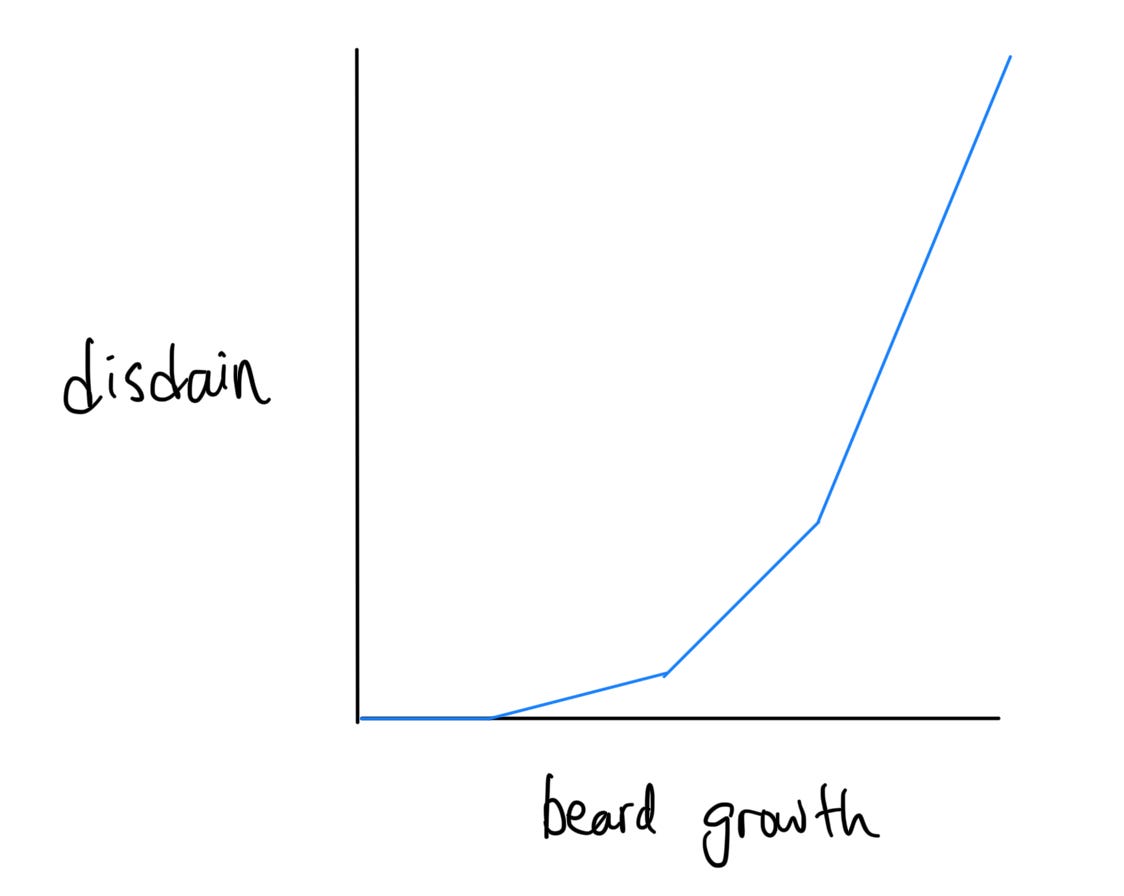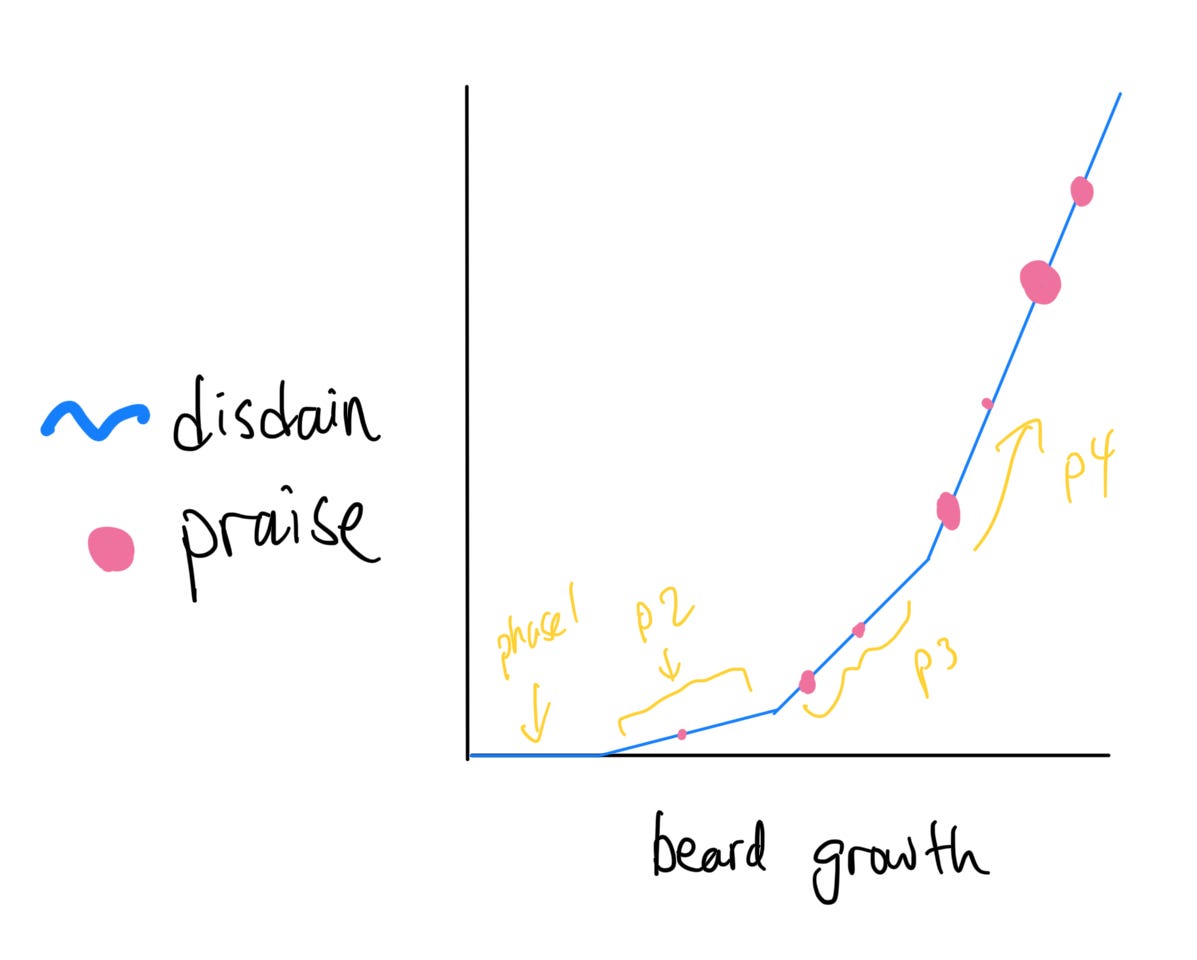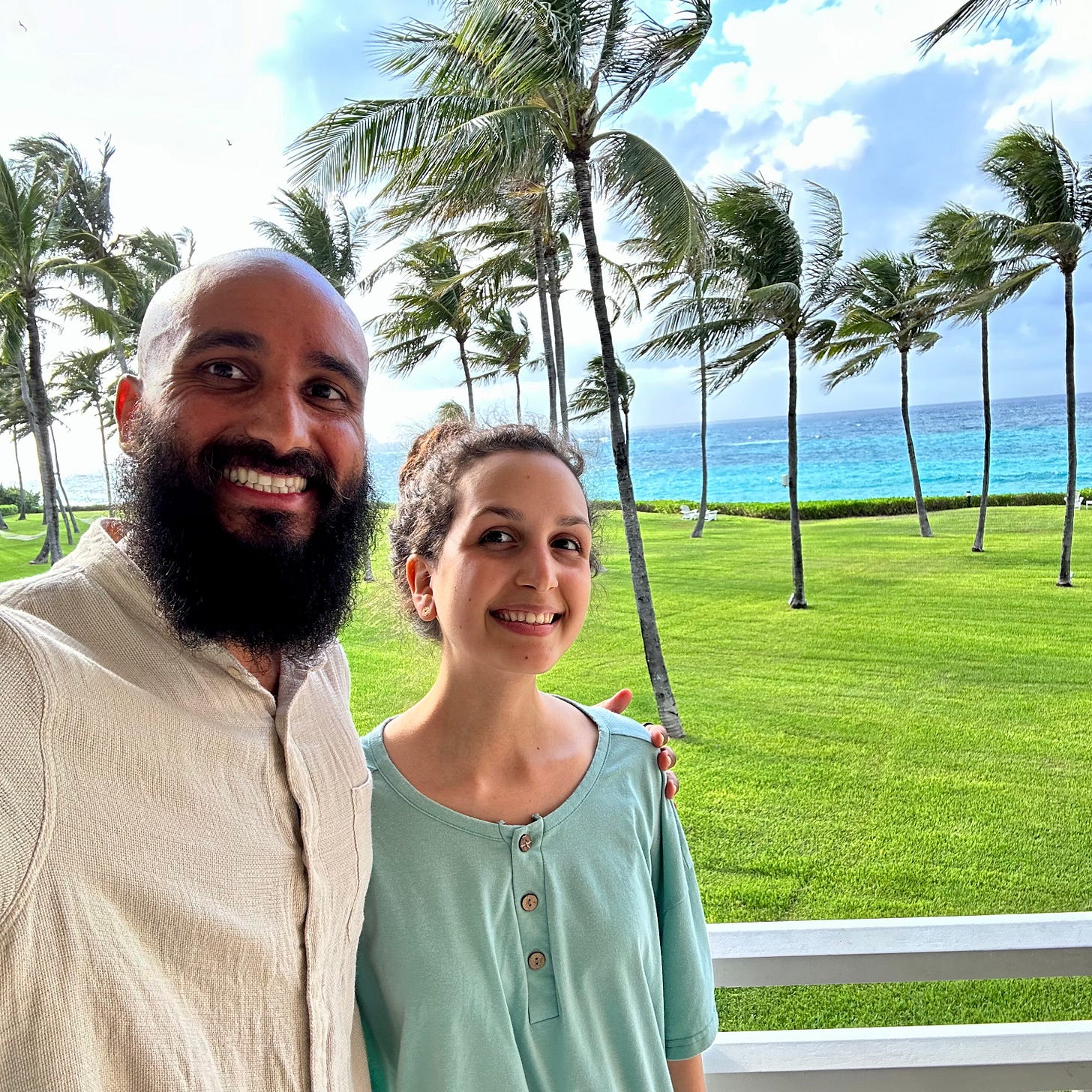Farewell, hairy companion
Over the past 6 months or so, I went through a fascinating experience. My facial hair ended up getting a break from the regular barrage of blades. As expected, my facial hair gradually grew longer and longer.
It started off as a bit of laziness that went unnoticed. Gradually, the beard garnered more societal disdain the longer it grew. Here are my peer-reviewed scientific findings:
Some helpful notes:
‘Beard growth’ is measured in length.
‘Disdain’ is measured in the quantity and intensity of disdain that was explicitly communicated to me using spoken or written language. It does not factor in any implicit or otherwise unexpressed disdain that was undoubtedly present as well.
There were no personal attempts to reproduce these findings outside the Arab world (yet). I predict that the graph will have regional differences that will provide insights into the given area’s culture.
There are 4 main phases to the relationship between beard growth and disdain:
Phase 1: The safe zone.
A certain amount of growth is not met with any disdain whatsoever.
Phase 2: Warning signs.
During this phase, people start to notice that this beard is getting out of line.
Disdain, here, is usually limited to a close circle of family and friends. It is also limited in frequency and intensity.
Phase 3: Serious business.
Here the beard’s sphere of influence continues to grow (literally and metaphorically), although still mostly within the realm of family and friends.
The beard becomes a repeated topic of discussion in gatherings. Jokes are made about it. Numerous theories come up to try to resolve the mystery of its existence.
People you haven’t seen in a while will start off any interaction with an inquisition about the beard’s motives.
Anyone who might have been holding back their feelings during phase 2, tends to come clean during this phase. Particularly true for my aunts, most of whom took me to the side and threatened to shave it off themselves if I didn’t resolve this matter on my own.
Phase 4: Public disdain
The beard’s sphere of influence makes waves beyond people I know personally, into the public domain.
My family gave up their resistance and despairingly surrendered to the beard’s relentless growth. Disdain still manages to sneak through.
Strangers show signs of disdain. For example, one day, as I was driving across the Saudi causeway, the immigration officer blurted out, “What’s going on with the beard?! Why? I mean, you seem like a nice person.”
During this phase, I occasionally experienced unusual signs of reverence from complete strangers as well. I was in a Majlis (‘sitting places' where community members gather, usually for particular occasions) during Eid, and as I was leaving someone I’d never even had a direct conversation with before said something along the lines of, “It really made my day to see someone like you. Holding onto our traditions and values, and doing so with such a positive attitude. You’re a great representative of our religion. Thank you so much. God bless you.”
Every single day, often multiple times a day, I’d hear (usually, but not always, derogative) comments about the beard.
I must express that although the beard managed to thrive in spite of overwhelming disdain and opposition, there were occasional shows of extreme love and support that were duly noted. Although sparse, hard to come by, these displays of support were powerful … imbued with admiration, often a tinge of envy, and willing the beard to live on and prosper. For reference, throughout the lifespan of the beard, the ratio of disdain to praise was about 500:1.
The beard witnessed a total 7 counts of explicit praise. The single instances are mapped out in pink dots.
Interesting to note a general increase in praise intensity proportional to beard growth, similar to what is experienced with disdain.
“Why are you growing your beard?!?!”
The beard garnered more societal disdain the longer it grew. For some reason, as soon as I became aware of this, sometime during phase 2, I wanted to lean into it more.
It was hard for me to acknowledge this feeling at first, but eventually it became clear as day.
There may be an element of stubbornness. I’ll be the first to admit that I can be quite stubborn. Not wanting to conform to norms just for the sake of conformity. But that’s not all it was …
I enjoyed being the butt of jokes. I embraced the challenge of accepting constant criticism with a smile, in complete equanimity. I wholeheartedly accepted being less aesthetically pleasing to people, and loved myself regardless.
For me, growing a beard was a meditation in letting go of my ego.
As a result of complex cultural and historical reasons I won’t get into, beards have the power to elicit extreme feelings in the Arab world. These can be negative or positive emotions. It was a fascinating experience … accidentally coming across a ‘phase 2 beard’, then using it as tool to try to become a better, more peaceful person.
(Left: hairless head, hairy face. Right: Hairy head, hairless face.)
Farewell, hairy companion. I’ve learnt a lot from you.
The biggest lesson you taught me is the power of smiling in the face of adversity, with nothing but love.
Maybe we’ll meet again someday.




This was entertaining to read 🫡
Now a follow up after u shave it off if u haven’t already !